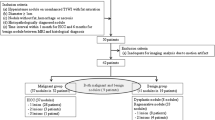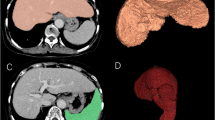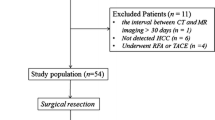Abstract
To evaluate the effect of technetium-99m-labeled DTPA-galactosyl human serum albumin (Tc-99m-GSA) SPECT imaging for qualitative diagnosis of hepatic lesions.
The subjects were 29 patients with pathologically confirmed hepatic lesions (21 malignant and 8 benign lesions). SPECT data were obtained at about 30 minutes after injecting 185 MBq (5 mCi) of Tc-99m-GSA. The GSA SPECT findings were compared with those of pathological evaluation and T2-weighted MR images (T2WI).
Of 29 lesions, 17 showed decreased accumulation, and three exhibited increased accumulation. The other nine lesions were undetectable. The malignant lesions which showed increased accumulation were all well differentiated hepatocellular carcinomas (HCCs). One of the eight benign lesions exhibited increased accumulation. The three lesions which showed increased accumulation of GSA exhibited hypointensity on T2WI, whereas the malignant lesions which showed decreased accumulation of GSA exhibited hyperintensity on T2WI.
The GSA SPECT findings correlate well with those of T2WI. GSA SPECT may be useful for qualitative diagnosis of focal liver lesions. If a lesion is suspected of being HCC, increased accumulation may indicate well differentiated HCC.
Similar content being viewed by others
References
Kudo M, Todo A, Ikekubo K, Hino M. Receptor index via hepatic asialoglycoprotein receptor imaging: Correlation with chronic hepatocellular damage.Am J Gastroenterol 87: 865–870, 1992.
Ha-Kawa SK, Tanaka Y. A quantitative model of technetium-99m-DTPA-galactosyl-HSA for the assessment of hepatic blood flow and hepatic binding receptor.J Nucl Med 32: 2233–2240, 1991.
Kudo M, Todo A, Ikekubo K, Hino M, Yonekura Y, Yamamoto K, et al. Functional hepatic imaging with receptor-binding radiopharmaceutical: Clinical potential as a measure of functioning hepatocyte mass.Gastroenterol Jpn 26: 734–741, 1991.
Koizumi K, Uchiyama G, Arai T, Ainoda T, Yoda Y. A new liver functional study using Tc-99m DTPA-galactosyl human serum albumin: Evaluation of the validity of several functional parameters.Ann Nucl Med 6: 83–87, 1992.
Aburano T, Shuke N, Yokoyama K, Tonami N, Hisada K, Tanei M, et al. Discordant hepatic uptake of Tc-99m NGA and Tc-99m PMT in a patient with hepatoma.Clin Nucl Med 17: 793–796, 1992.
Hyodo I, Mizuno M, Yamada G, Tsuji T. Distribution of asialoglycoprotein receptor in human hepatocellular carcinoma.Liver 13: 80–85, 1993.
Stadalnik RC, Vera DR, Woodle ES, Trudeau WL, Porter BA, Ward RE, et al. Technetium-99m NGA functional hepatic imaging: Preliminary clinical experience.J Nucl Med 26: 1233–1242, 1985.
Virgolini I, Muller C, Klepetko W, Angelberger P, Bergmann H, O’Grady J, et al. Decreased hepatic function in patients with hepatoma or liver metastasis monitored by a hepatocyte specific galactosylated radioligand.Br J Cancer 61: 937–941, 1990.
Sawamura T, Nakada H, Hazama H, Shiozaki Y, Sameshima Y, Tashiro Y. Hyperasialoglycoproteinemia in patients with chronic liver diseases and/or liver cell carcinoma. Asialoglycoprotein receptor in cirrhosis and liver cell carcinoma.Gastroenterol 87: 1217–1221, 1984.
Naitoh Y. Hyperasialoglycoproteinemia in patients with chronic liver disease.Acta Hepatol Jpn 28: 1179–1187, 1987. (in Japanese)
Kubota Y, Kojima M, Hazama H, Kawa S, Nakazawa M, Nishiyama Y, et al. A new liver function test using the asialoglycoprotein-receptor system on the liver cell membrane: I. Evaluation of liver imaging using the Tc-99m-neoglycoprotein.KAKU IGAKU (Jpn J Nucl Med) 23: 899–905, 1986. (in Japanese)
Kurtaran A, Muller C, Novacek G, Kaserer K, Mentes M, Raderer M, et al. Distinction between hepatic focal nodular hyperplasia and malignant liver lesions using technetium-99m-galactosyl-neoglycoalbumin.J Nucl Med 38: 1912–1915, 1997.
Kudo M, Hirasa M, Takakuwa H, Ibuki Y, Fujimi K, Miyamura M, et al. Small hepatocellular carcinomas in chronic liver disease: Detection with SPECT.Radiology 159: 697–703, 1986.
Muramatsu Y, Nawano S, Takayasu K, Moriyama N, Yamada T, Yamasaki S, et al. Early hepatocellular carcinoma: MR imaging.Radiology 181: 209–213, 1991.
Kudo M, Ikekubo K, Todo A, Mimura J, Okabe Y, Kashida H, et al. Clinical utility of receptor imaging in the assessment of liver function.Jpn J Gastroenterol 89: 1349–1359, 1992. (in Japanese)
Mitchell DG, Stark DD. Benign hepatocellular masses.In: Mitchell DG, Stark DD, eds.Hepatobiliary MRI: A Text-Atlas at Mid and High Field, St. Louis: Mosby Year Book, pp. 111–124, 1992.
Matsui O, Kadoya M, Kameyama T, Yoshikawa J, Arai K, Gabata T, et al. Adenomatous hyperplastic nodules in the cirrhotic liver: Differentiation from hepatocellular carcinoma with MR imaging.Radiology 173: 123–126, 1989.
Takayama T, Makuuchi M, Hirohashi S, Sakamoto M, Okazaki N, Takayasu K, et al. Malignant transformation of adenomatous hyperplasia to hepatocellular carcinoma.Lancet 336: 1150–1153, 1990.
Paulson EK, Baker ME, Spritzer CE, Leder RA, Gulliver DJ, Meyers WC. Focal fatty infiltration: A cause of nontumorous defects in the left hepatic lobe during CT arterial portography.J Comput Assist Tomogr 17: 590–595, 1993.
Matsui O, Takahashi S, Kadoya M, Yoshikawa J, Gabata T, Takashima T, et al. Pseudolesion in segment 4 of the liver at CT during arterial portography: Correlation with aberrant gastric venous drainage.Radiology 193: 31–35, 1994.
Author information
Authors and Affiliations
Corresponding author
Rights and permissions
About this article
Cite this article
Saito, K., Koizumi, K., Abe, K. et al. Potential for qualitative diagnosis of tumors and tumorous lesions in the liver with Tc-99m-GSA SPECT —Correlation with pathological evaluation and MRI findings—. Ann Nucl Med 12, 275–280 (1998). https://doi.org/10.1007/BF03164913
Received:
Accepted:
Issue Date:
DOI: https://doi.org/10.1007/BF03164913




